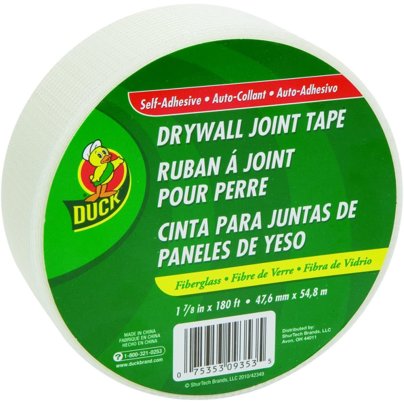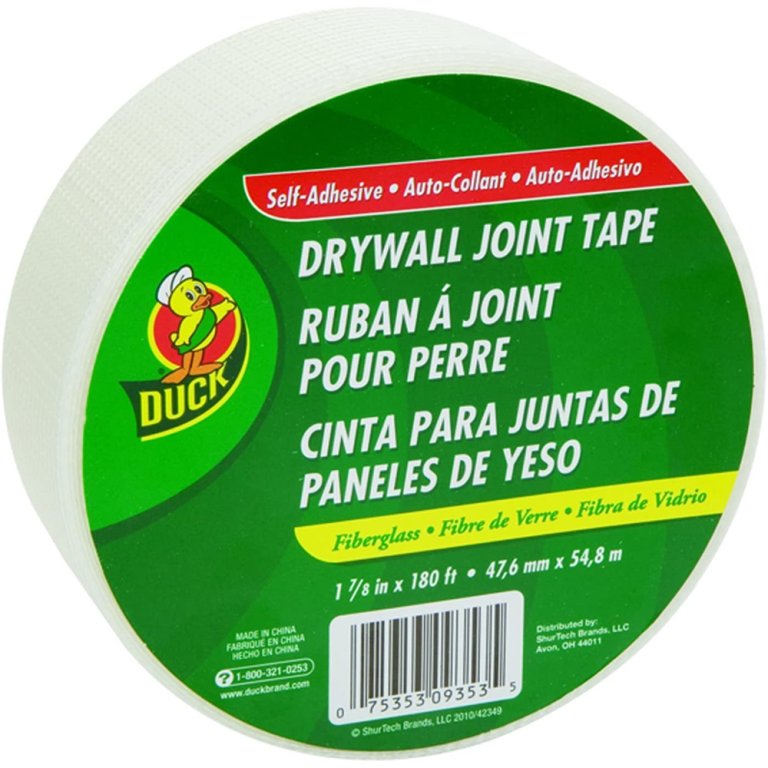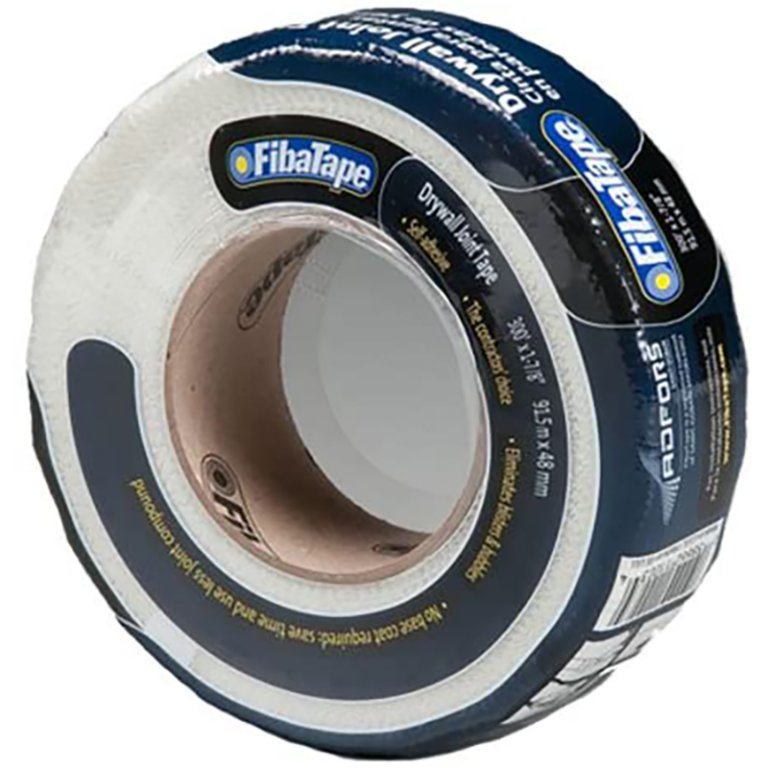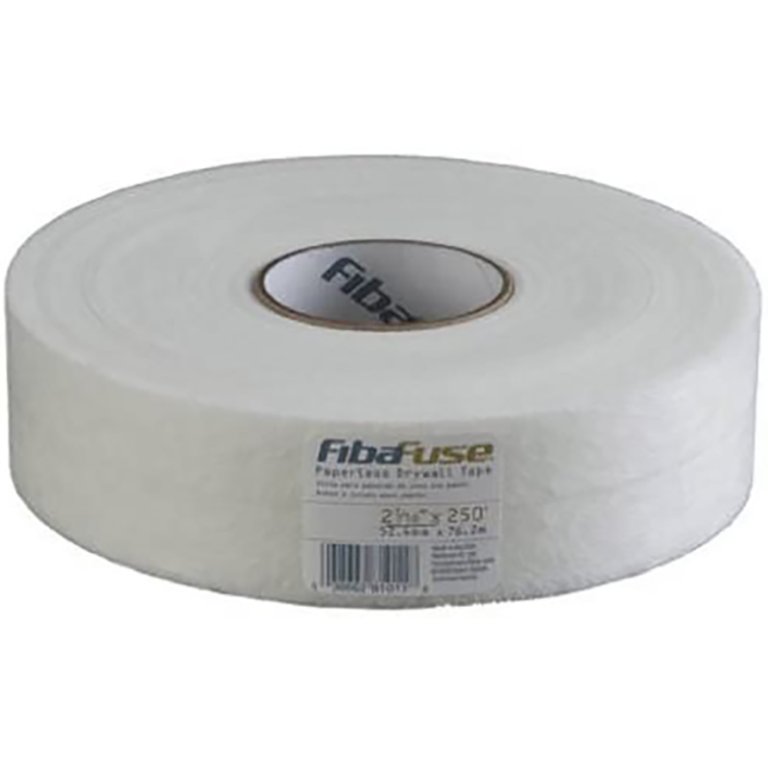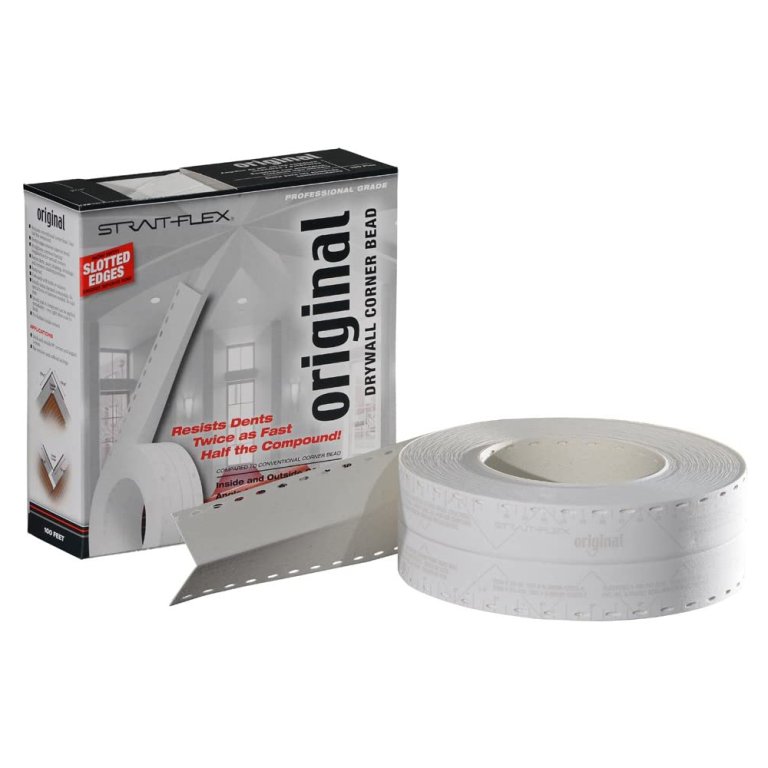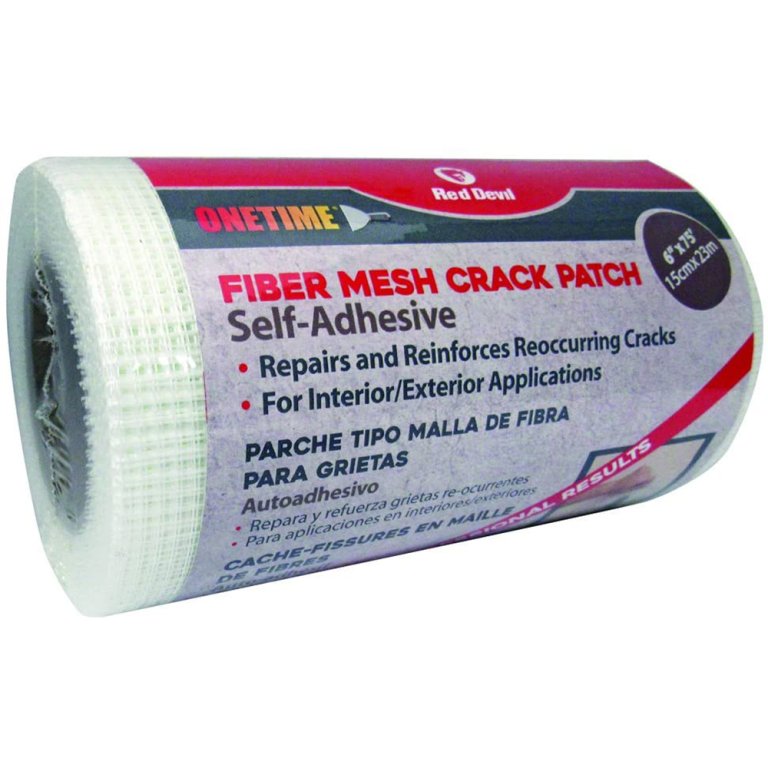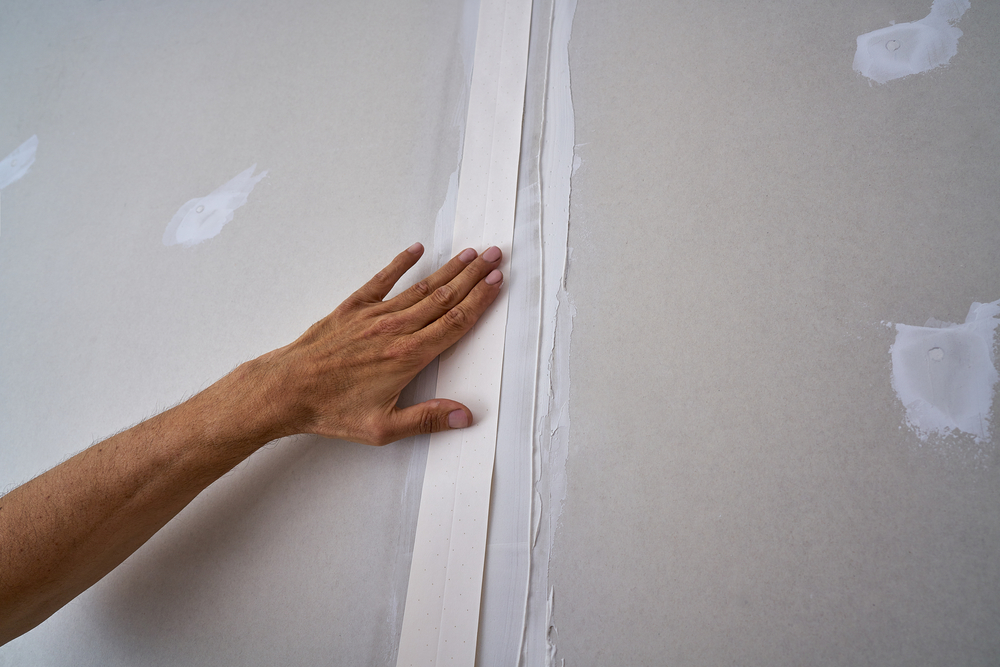
We may earn revenue from the products available on this page and participate in affiliate programs. Learn More ›
Achieving a smooth, flat finish on interior walls that lasts can be tricky. The joints between drywall panels must be filled with wet joint compound, smoothed out, and then sanded to remove bumps and ridges. However, when drywall tape is used to hold the compound in place, it is less likely to crumble away when shifting occurs. The right drywall tape also provides an optimal surface for creating a smooth look, repairing walls and fixing drywall cracks, and resisting humidity.
This guide outlines various types of drywall tape, some key considerations to consider, and some top products currently available.
- BEST OVERALL: Duck Brand 282083 Drywall Joint Tape
- BEST BANG FOR THE BUCK: LYLTECH Drywall Joint Tape
- BEST FIBERGLASS MESH: Saint-Gobain ADFORS FDW6581-U FibaTape Drywall Tape
- BEST MOLD RESISTANCE: FibaFuse FDW8201-U Paperless Drywall Tape
- BEST FOR CORNERS: STRAIT FLEX SO-100 Original Composite Tape
- BEST FOR CRACKS: Red Devil 1226 Onetime Fiber Mesh Crack Patch

Types of Drywall Tape
The purpose of drywall tape is simple: It helps hold the joint compound in place. Without the tape to support it, the wet joint compound is more likely to sag out of the joints. But installation differs depending on the type of tape you choose. Some types of tape are embedded in a coat of compound that goes on the wall first. Mesh tape, on the other hand, is positioned over a wall seam, and compound is applied over the tape, allowing it to ooze through perforations in the tape and into the seam beneath. To select the right type of drywall tape, check out these variations and characteristics.
Non-Adhesive/Paper Tape
In the world of professional taping, paper drywall tape is king. Paper drywall tape comes in rolls about 2 inches wide and anywhere from 50 to 200 feet long. Paper drywall tape is the thinnest tape, and the thinner the tape, the less visible the finished seam. This means that paper produces the smoothest possible seams—but only if used correctly. Paper tape is applied over a layer of wet joint compound used to fill a joint between drywall panels. The tape is embedded in the compound using a taping knife, and additional compound is smoothed over the tape to cover it.
Pro drywall installers often only use paper drywall tape, but it can pose a problem for DIYers who may use too little or too much compound. Such errors can result in the tape shifting or wrinkling or bubbles to appear on the tape’s surface. For speedy installation, rolls of paper tape are often fitted into drywall tape dispensers to allow installers to apply compound and tape at the same time.
Note that standard paper drywall tape comes with an embossed line down its center to create a crease to form a 90-degree angle for use in an inside corner. Use this same paper tape flat as described to tape joints in the center of the wall. As with flat seams, joint compound first must be applied to an inside corner, after which the tape is folded and embedded in the compound.
Self-Adhesive Tape
Embedding tape smoothly in compound takes practice and experience, but self-adhesive drywall tape may make it easier. Rather than applying the tape over a layer of compound, self-adhesive tape features a sticky backing that lets the user position it directly over a dry joint between panels.
The tape is made with an open-weave mesh, so the joint compound can flow through and fill the seam beneath. This type of tape is much simpler to use than paper, but take care to smooth enough compound through the surface mesh to fill the seam beneath. If too little compound is used, the joint is more likely to develop cracks later. Fiberglass mesh tape is the most common material used for self-adhesive options.
Mold and Moisture Resistant Tape
Since some areas are exposed to more moisture than others, some may need a moisture- or mold-resistant option.
Moisture-resistant drywall tape may contain fiberglass or other water-resistant components; pair it with moisture-resistant drywall panels. This type of tape is typically used in bathrooms, basements, or any other rooms in which humidity is probably high. It’s usually self-adhesive with an open weave, so users can attach it over the seam before they apply the compound. However, it’s also available in a non-stick version, which should be embedded over wet compound like paper tape.
Most moisture-resistant brands of drywall tape are also mold and mildew resistant, and they may contain fiberglass or other components that naturally resist mold growth. It’s a good idea to use mold-resistant tape in areas with high humidity.
Fire Resistant Tape
Local building codes may require some walls, such as connecting walls between attached garages and homes, to hold a 1-hour fire rating. This rating means the wall is constructed so that it can prevent fire from spreading from one side of the wall to the other for at least an hour. In some cases, regular drywall tape and joint compound can be used in conjunction with fire-resistant (Type X) drywall on a fire-rated wall. In other situations, the local building authority may require a special fire-resistant tape, which features a foil backing that won’t burn.
Be sure to check local codes before starting a project—they differ from one community to another. When fire-resistant tape is required, the entire wall must be constructed to meet fire codes, including the installation of special electrical outlets and doors that seal to slow the spread of fire.
What to Consider When Choosing the Best Drywall Tape
Choosing the best drywall tape for a project depends on how many seams installers have to tape, their skill level, and if the seams appear on a flat portion of a wall or in a corner. When purchasing drywall tape, consider roll length (to determine how much is required) and the application method.
Length per Roll
Both standard paper drywall tape and flexible mesh tape come in rolls up to 200 feet in length, and the standard rule of thumb for estimating the necessary amount is to purchase 1 foot of tape for every 2 square feet of wall. For example, if the room is 8 feet by 10 feet and the walls are 8 feet high, that equals 640 square feet of wall, so purchase 320 linear feet of drywall tape. While taping out a joint or seam requires two or more thin coats of compound, the tape itself is used only once—with the initial application of compound—so there’s no need to buy more tape than required for one application.
Application
The main difference between adhesive and non-adhesive drywall tape is how the tape is applied. Non-adhesive tape, such as paper tape, must be embedded in a layer of wet joint compound applied to seams between panels before the tape goes on. Self-adhesive drywall tape, on the other hand, is positioned over the seam before the application of joint compound.
Pros employ the first method, and for them, it’s faster. However, DIYers may find the non-adhesive tape slips around too much on the wet compound, making it difficult to position directly over the seam. Also, wrinkles may form in the tape that are difficult to smooth out. DIYers may prefer self-adhesive tape, because once it’s applied over the seam, it stays put. After that, installers smooth the compound over it, pushing the compound through the mesh surface and into the seam beneath.
Inside vs. Outside Corners
Creased paper drywall tape is usually used only on inside corners. There, flexible tape will likely fail to hold a sharp crease down the center. Outside corners are typically formed by installing rigid plastic or metal corner pieces over the drywall (called a “corner bead”), which are then attached with compound, adhesive, or even nails, depending on the type of bead.
A handful of reinforced creased tape is labeled for use on both inside corners and outside corners, and this type should be embedded in compound. However, for novice tapers, a corner bead probably offers the best results on outside corners.
Flexibility
Most drywall tapes, with the exception of paper, are slightly flexible, which means they can be smoothed over a rounded wall corner without gaping. Flexibility, however, doesn’t mean that the tape should be stretched; doing so could cause it to pull away from the drywall later and leave a gap. Flexible tape is not recommended for use on inside corners, because it lacks rigidity and will not hold a sharp crease down the center.
Our Top Picks
To qualify as a top pick, each type of drywall wall tape should be durable, with the ability to stick securely to wet joint compound. While ease of use varies by type and the user’s taping skills, each of the following drywall tapes are good choices.
Best Overall
Duck Brand 282083 Drywall Joint Tape
See ItPros
- Strong mesh tape
- Can be cut if needed
- Easy to apply
Cons
- May cause damage to drywall, paint, or other flat surfaces if removed
Product Specs
- Type: Self-adhesive
- Length: 180 feet
- Width: 1 7/8 inches
- Material: Fiberglass mesh
Novice tapers or even those with some experience may appreciate the convenience of Duck Brand Self-Adhesive Fiberglass Mesh Drywall Tape. It comes with an application of adhesive on its backside, so users often have to measure, cut, and apply the tape right over a dry seam.
This thin yet strong fiberglass mesh tape allows the joint compound to ooze through and fill the seam beneath. This Duck Brand tape is 1 7/8 inches wide and comes in a 180-foot roll—enough to tape out a 90-square-foot wall. If desired, cut the tape into smaller pieces to apply over existing cracks in walls.
Get the Duck Brand drywall joint tape at Amazon, Walmart, and Sears.
Best Bang For The Buck
LYLTECH Drywall Joint Tape
See ItPros
- Affordable tape
- Suitable for joint taping and patching cracks
- Strong, rubber-based adhesive
Cons
- Some users have reported unraveling
- Adhesive may not be as strong as comparable options
Product Specs
- Type: Self-adhesive
- Length: 180 feet
- Width: 1 7/8 inches
- Material: Fiberglass mesh
One common reason for tackling a DIY job is to save money, and LYLTECH Drywall Joint Tape allows just that. This self-adhesive thin fiberglass tape sticks securely to dry drywall when taping joints. The tape, which is 1-7/8 inches wide and comes in a 180-foot roll, offers the same amount as many other higher priced tapes.
Designed for regular joint taping, it also comes in handy for patching cracks in walls. As with other self-adhesive drywall tapes, LYLTECH fiberglass mesh tape goes on the wall first, followed by an application of joint compound smoothed over the tape to push the wet compound into the joint beneath.
Get the LYLTECH drywall tape on Amazon and at Sears.
Best Fiberglass Mesh
Saint-Gobain ADFORS FDW6581-U FibaTape Drywall Tape
See ItPros
- Easy to apply
- Mold- and mildew-resistant
- Suitable for bathrooms and basements
- Extra-strong design
Cons
- Some users report ineffective use
Product Specs
- Type: Self-adhesive
- Length: 300 feet
- Width: 1 7/8 inches
- Material: Fiberglass mesh
The open-weave fiberglass mesh on Saint-Gobain ADFORS FibaTape Drywall Tape allows users to create smooth, solid seams with ease. Cutting the self-adhesive tape and attaching it over a dry joint, then applying compound on top, is a fairly simple process.
This thin fiberglass tape is mold- and mildew-resistant, which makes it well-suited for bathroom and basement projects. Plus, it’s extra strong thanks to the holding power of fiberglass, which helps hold the compound in place and reduces the risk of cracking. FibaTape is 1-7/8 inches wide and comes in a hefty 300-foot roll.
Get the Saint-Gobain FibaTape tape at The Home Depot and Lowe’s.
Best Mold-Resistant
FibaFuse FDW8201-U Paperless Drywall Tape
See ItPros
- Mold-resistant
- Fits in professional-grade tape-dispensing tools
- Suitable for DIY and professional use
Cons
- Takes some work to install
Product Specs
- Type: Non-adhesive
- Length: 250 feet
- Width: 2 1/16 inches
- Material: Glass fibers
Those looking for a mold-resistant alternative to paper that’s not self-adhesive may want to check out FibaFuse Paperless Drywall Tape. Made from glass fibers, this tape resists mold growth, which makes it good for use in rooms with high humidity, such as bathrooms and basements.
Like paper tape, the 250-foot FibaFuse must be embedded in an initial layer of joint compound with additional thin coats of compound applied on top. Also like paper tape, this ultra-thin drywall tape fromFibaFuse fits in professional tape-dispensing tools such as banjos and super tapers. Skilled drywall installers often prefer this type of tape.
Get the FibaFuse drywall tape on Amazon and at Walmart.
Best For Corners
STRAIT FLEX SO-100 Original Composite Tape
See ItPros
- Slotted holes on the edges
- Suitable for use on corners
- Thick and durable
Cons
- Pricey compared to similar options
- Not as rigid as corner bead
- Requires embedding with a drywall compound
Product Specs
- Type: Non-adhesive
- Length: 100 feet
- Width: 2 3/8 inches
- Material: Composite
With a substantial composite backing and a paper face, STRAIT FLEX Original Composite Drywall Tape is designed to create crisp inside and outside corners. At 2 3/8 inches wide, this tape is not only wider than standard paper tape, but it’s also thicker and stronger, necessary elements for covering the gaps that often occur where drywall panels meet in corners. STRAIT FLEX, which replaces regular creased paper tape for inside corners, can also be used as a replacement for solid corner bead when taping outside corners.
It’s not quite as rigid as corner bead, so if applying it to outside corners poses a problem, consider using regular corner bead in those spots. Like paper tape, this corner tape should be embedded in drywall compound. But, the slotted holes on the edges hold onto adhesive easily. It comes in a 100-foot roll.
Get the STRAIT FLEX composite tape on Amazon and at The Home Depot.
Best For Cracks
Red Devil 1226 Onetime Fiber Mesh Crack Patch
See ItPros
- Suitable for repairing cracks
- Can be cut if needed
- Suitable for use with a drywall compound or spackle
Cons
- Limited length compared to similar options
Product Specs
- Type: Self-adhesive, mold- and mildew-resistant
- Length: 75 feet
- Width: 6 inches
- Material: Fiber mesh
When a house inevitably settles, cracks may appear above doors and windows, marring the look of the entire wall. Specifically developed to help create a smooth repair over cracks, 6-inch-wide Red Devil Fiber Mesh Crack Patch Tape can be cut with scissors to fit any length of crack.
Its self-adhesive backing means it sticks securely to the wall, after which drywall compound or spackling should be applied over it to fill the crack and create a smooth surface. Mold- and mildew-resistant, this tape comes in a 75-foot roll.
Get the Red Devil crack patch on Amazon and at Walmart.
Our Verdict
For a reliable drywall tape that is easy to use and effective, the Duck Brand tape can cover a 90-square-foot wall with the help of built-in adhesive making it suitable for cracks and holes in drywall. Alternatively, for a budget-friendly option, the LYLTECH joint tape is a fiberglass mesh drywall tape suitable for repairing joints and cracks with a strong, rubber-based adhesive that sits on drywall effectively.
How We Chose the Best Drywall Tapes
We researched the most sought-after drywall tapes in their respective categories and discovered that the best models are determined by their type, length and coverage area, materials, and other special features included by select brands.
For ease of application in dry or moist locations, our top picks include self- and non-adhesive options with some products offering moisture- and mold-resistance. The above list also prioritizes variety with glass, composite, and thin fiberglass tape included for repairing cracks, joints, corners, and other drywall repairs.
Most drywall tapes included in this list have lengths of 75 to 300 feet per roll with widths of 1 7/8 to 6 inches for small or large repairs. Some of our included picks can also fit into professional-grade tape dispensers, can be cut if needed, or have slotted holes for added adhesive capabilities.
Tips for Using Drywall Tape
Taping drywall is the application of both joint compound and drywall tape to smooth out joints and make the wall have a flat, solid surface.
- Joint compound shrinks slightly as it dries, so it’s better to apply two or three very thin coats—allowing the compound to dry and sanding between each coat—rather than a single thick coat that can ripple as it dries and require extensive sanding to smooth out.
- Don’t overlap tape. Apply drywall tape in a single layer.
- Mix only small amounts of joint compound at a time. Once the drywall compound begins to set, it can harden within minutes, so small batches help reduce waste.
FAQs
It’s only natural for first-time drywall DIYers to have some questions. Find some of the most frequently asked questions—and their answers—here.
Structures have inside and outside corners. The standard method of taping inside corners is to apply joint compound to the corner and then embed a pre-creased section of paper or composite drywall tape in the corner, smoothing it into place with a taping knife. Outside corners are typically formed by attaching rigid drywall corner bead, so it overlaps the entire corner before applying mud compound over the surface of the bead in multiple thin coats—allowing each coat to dry in between applications.
If it didn’t make good contact with the wall during the application process, drywall tape can come loose. This is usually the result of not using enough compound on the joint before embedding the tape.
If drywall tape has bubbled, cracked, or pulled away from a joint, cut away the damaged section with a razor knife and apply a new piece of tape in its place, using compound to install it.
If you plan to paint the wall or hang wallpaper on it, yes, the joints should be taped to give the appearance of a smooth wall. If you’re planning to install floor-to-ceiling paneling—and the drywall won’t be visible—it’s not necessary to tape out the joints.
